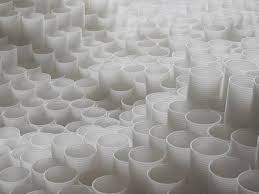So after frantically trying to gather all my materials, I finally began and nearly finished creating my art piece! This work is totally interactive and the pipes slide in and out so anyone can create their own version. In the photo below, it is missing one tube because it cracked. It will soon be replaced and the entire box will be filled. It was a long, cold day in my garage but with some help from my dad, I completed the construction! Now all I have to do is clean it up and decide on whether I should paint or stain it tomorrow.
Though the design is somewhat simple, making this piece took a lot more consideration than I originally thought. Because I had rendered it out on SolidWorks, it was already scaled out. But because I was using a 1/8 circular saw blade, the loss of 1/8 of material had to be taken into account for the measurements of all of the cuts I made. So if a plank was supposed to be 11.5 inches, I had to add .125 when I measured, knowing that the .125 would be removed in the cutting process. I also had to take into consideration that I did not want the pipes TOO tightly packed so they could easily slide around one another, so I left a small space inside the frame (meaning I made the bottom and top horizontal pieces of wood a tad bit longer than necessary.) Since it had to fit six pipes across, I measured the diameter of the pipes, multiplied by six, added .125 for material loss, and another small fraction for the extra space.
Another measurement I made included the exact diameter and length of each pipe because though they were supposed to all be the same, there are always going to be some small variation in size. Because my smallest pipe was almost a half inch smaller than all of the other ones, I had to base our final cut length of pipe off of the smallest pipe. I only had enough pipes to make the EXACT amount of tubes, so it was crucial I use the pipes in the most efficient way.
Materials
Safety First!
Full Length Pipes and Circular Saw
Pipes
Wood Planks
Cutting the Pipes
The Wooden Frame
Constructing the Wooden Frame
Math
Measuring Pipes


























 I later decided to go for a different strategy… Popsicle sticks and a hot-glue gun. I found this was a much easier way for me to get creative without getting too sloppy or sore. My inspiration for this first piece came from the artist Nils Udo who was known for his giant nest earth structures. His work can be seen on my previous post. As I began to layer the sticks, I decided to keep layering and layering until the nest turned into a more 3 dimensional vessel with a volume inside.
I later decided to go for a different strategy… Popsicle sticks and a hot-glue gun. I found this was a much easier way for me to get creative without getting too sloppy or sore. My inspiration for this first piece came from the artist Nils Udo who was known for his giant nest earth structures. His work can be seen on my previous post. As I began to layer the sticks, I decided to keep layering and layering until the nest turned into a more 3 dimensional vessel with a volume inside.



 L
L
 STONE-TIME-MAN: quartzite monolith weighing about 150 tons, fir trunks blown over in storm, Forest Sculpture trail, Wittgenstein-Sauerland, Bad Berleberg, Germany, 2001
STONE-TIME-MAN: quartzite monolith weighing about 150 tons, fir trunks blown over in storm, Forest Sculpture trail, Wittgenstein-Sauerland, Bad Berleberg, Germany, 2001

 The Nest: earth, stones, silver birch, grass; Lineberg Heath,Germany, 1978
The Nest: earth, stones, silver birch, grass; Lineberg Heath,Germany, 1978 Waterhouse: spruce trunks, birch branches, willow switches and sod on tidal flats– Waddensee mudflats, Holland, 1982
Waterhouse: spruce trunks, birch branches, willow switches and sod on tidal flats– Waddensee mudflats, Holland, 1982